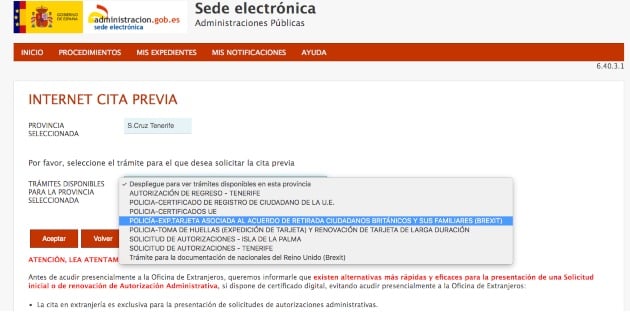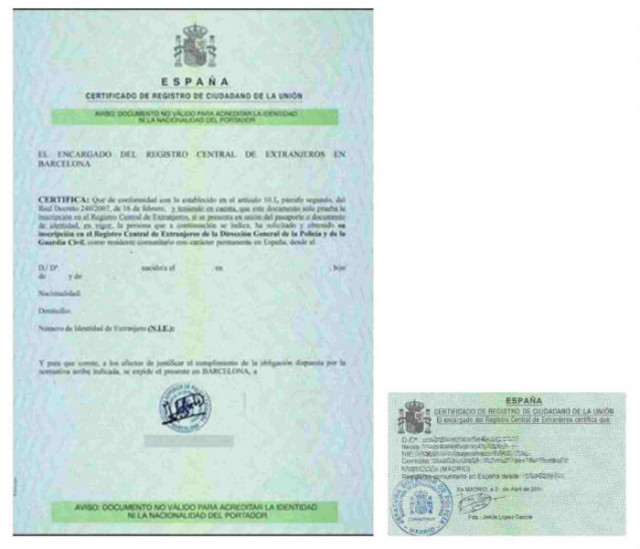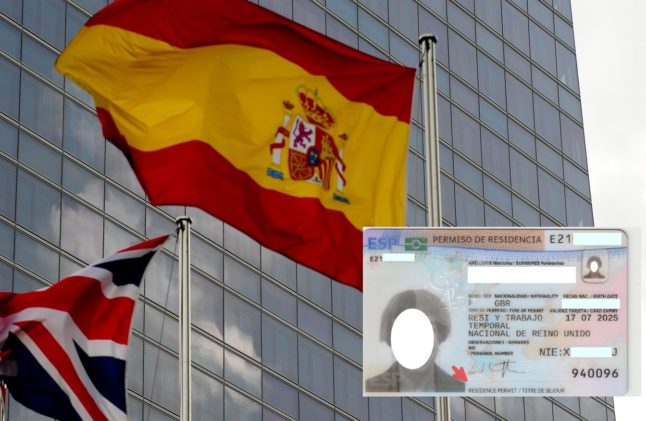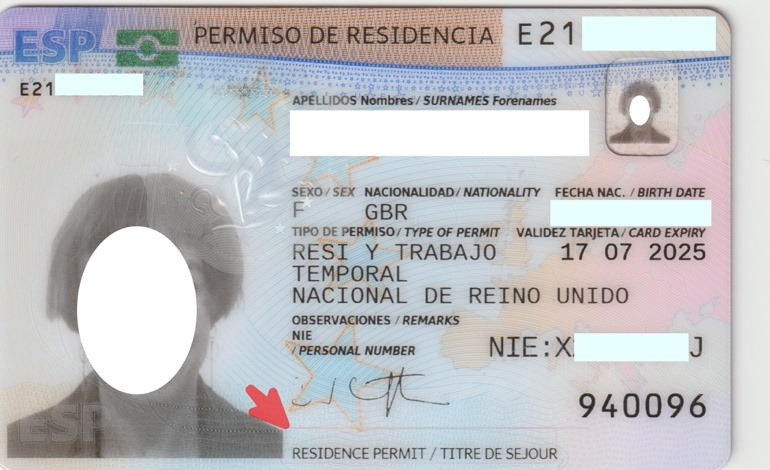In July, Spain introduced the TIE (Tarjeta de Identidad Extranjero) for British residents, a biometric credit card-sized photo ID that replaces the previously issued green residency A4 certificate or small green residency card.
It’s important to remember that for UK citizens who have already registered as residents in Spain and are in possession of either of these green residency documents, the TIE card is optional.
READ MORE:
- What Brits in Spain need to know about the new Brexit-friendly residency card
- BREXIT: When should British residents in Spain get a TIE?
That’s because both of these ‘residencia’ documents – whether temporary (less than 5 years of residence) or permanent (more than 5 years) – already guarantee Brits’ rights in Spain under the Withdrawal Agreement.
How do UK citizens who are already registered in Spain apply for a TIE?
We should reiterate again that for those who have green certificates this is not compulsory to do before the transition period ends on December 31st 2020.
But there are advantages to doing so and many people have already opted to swap their old green certificates for the TIE.
Go on the cita previa website, choose your province and the new option available for the TIE card issuance: “POLICIA-EXP. TARJETA ASOCIADA AL ACUERDO DE RETIRADA CIUDADANOS BRITÁNICOS Y SUS FAMILIARES (BREXIT)”.

Then fill in your personal details and make an appointment.
Before your appointment at the immigration office/police station, you will have to:
Fill in “modelo 790” (code 012), print it out and pay the processing fee at a bank. They will stamp the form to prove that you have paid or direct you to the ATM to use the system there. Take this receipt along to your appointment.
Fill in the EX-23 TIE application form and print it out to hand in during your appointment. DOWNLOAD HERE
Prepare to present your passport. In the event that your passport is expired or lost, you must show a copy and proof of the renewal application for it.
Present your Certificado de Registro de Ciudadano de la Unión (also known as Certificado de Registro Comunitario) which will be in the form of either the older A4 green paper certificate or a smaller green paper credit card size:

If you have changed address since your green certificate was last issued then you will need to show a “padron” certificate issued within the last three months.
Get a passport photo of yourself. To be completely sure it meets the requirements, have this done at a shop or photography studio where Spanish DNI (Spanish National ID) photos are taken.
There isn’t a timeframe yet for how long the TIE issuance takes, but when they do contact you for you to pick it up, you will again have to present your passport as proof of ID.
Holders of a green temporary registration certificate with less than five years of residency will receive a TIE valid for five years, whereas holders of a permanent residency certificate will get a TIE valid for ten years.
Why can’t I seem to make a “cita previa” appointment?
In some provinces, the Spanish Public Administration’s “cita previa” system isn’t allowing TIE appointments to be made, due to them being snatched up as soon as they’re made available and other administrative reasons.
There are also specific offices where appointments can only be made over the phone.
“I think it is safe to say that appointments should be made in order to obtain the TIE but the exact logistics may vary given the devolved powers given to regions in Spain,” Nigel Aston, head of Eurocitizens group, told The Local.
“The Spanish Government appears committed to detailed communication to the British community and we believe this will appear sooner rather than later.”
INSIDER TIP: Many of the appointments are block booked by immigration “gestores” (agents) so if you are willing to pay, you can bypass the process and employ someone to do it for you.
How do UK citizens apply for a TIE if they’ve never registered in Spain?
This is a two-step process for Brits registering in Spain for the first time.
If you intend to reside in Spain post-Brexit, it is highly recommendable that you begin this process as soon as possible and before the end of the transition period in order to benefit from the rights under the Withdrawal Agreement.
First you have to apply for residency, then you have to apply for the TIE in the same way as already registered residents can (although for them it’s optional, whilst for you it will be mandatory as this will become your official residency document).
You will need to make an appointment, present several documents in person and prove among other things that you have health cover and the financial means necessary to live in Spain, either by showing a work contract, self-employed accounts, your pension entitlement or proof of self-sufficiency by showing savings.
You must submit your residence application to the immigration office (Oficina de Extranjeros) in the province where you live.
You can do this electronically (if you have a digital signature ‘firma digital’), in person by appointment at the immigration office or via a third party representative who can submit your application, electronically or in person, on your behalf.
You will need to provide the following documentation:
- application form EX20
- passport
- documentation which demonstrates your residence in Spain before 31 December 2020
- documentation which demonstrates you meet the EU residence criteria on income and healthcare
Make sure you read the specific instructions provided when submitting your application online or when booking an appointment, on any additional documentation required in your province.
If you submit your application in person, many immigration offices will also require you to provide photocopies of official documents such as your passport at your appointment.
Submitting your application electronically
You can submit your residency application and supporting documents using the Spanish administration’s online platform (Sede electronica) as long as you have a digital signature:
- enter the online portal
- click ‘continuar nueva solicitud’
- choose ‘EX-20 – Documento de residencia Artículo 50 TUE para nacionales del Reino Unido (emitido de conformidad con el artículo 18.4 del Acuerdo de retirada)’
Submitting your application in person
To submit your application and documents in person, you must first request an appointment at the immigration office. In many provinces you must do this online via the public administration website:
- choose your province
- select ‘trámites oficinas de extranjería’ (if this option is available)
- choose the option ‘Trámite para la documentación de nacionales de Reino Unido (Brexit)’
In some regions this last option is not available and first time applicants must contact the immigration office by telephone or by email. For example, in:
- Malaga – call +34 95 298 04 60 and select OPTION 5 to request your appointment
- Barcelona – email [email protected] to request your appointment
- Madrid – email the appointment request form, the EX20 application form and your supporting documentation to [email protected]
- Valencia – email the EX20 application form and your supporting documents to [email protected]
If you are not sure how to request an appointment, contact the immigration office in your province.
Once you have applied for first time residency:
Within a maximum period of three months, you will receive an answer on the resolution of your residency application.
The receipt of your application for residency will be sufficient proof for you to remain in Spain legally until you have a resolution.
If it’s favourable, you can move onto the second step: requesting your TIE card to be issued.
You have to do this within 30 days of receiving an answer about your residency.
Then the steps are the same as for already registered residents who want to swap their green residency documents for TIEs.
Go on the cita previa website, choose your province and the new option available for the TIE card issuance: “POLICIA-EXP. TARJETA ASOCIADA AL ACUERDO DE RETIRADA CIUDADANOS BRITÁNICOS Y SUS FAMILIARES (BREXIT)”.
Then fill in your personal details and make an appointment.
Before your appointment at the immigration office/police station, you will have to:
Fill in “modelo 790” (code 012), print it out and pay the processing fee at a bank. They will either stamp the form to prove that you have paid or there will be the option of doing it at the ATM itself, in which case the bank teller will give you a sheet of instructions to follow. Take the reciept along to your appointment.
Fill in the EX-23 TIE application form and print it out to hand in during your appointment. DOWNLOAD HERE
Prepare to present your passport. In the event that your passport is expired or lost, you must show a copy and proof of the renewal application for it.
Get a passport photo of yourself. To be completely sure it meets the requirements, have this done at a shop or photography studio where Spanish DNI (Spanish National ID) photos are taken.
There isn’t a timeframe yet for how long the TIE issuance takes, but they will either give you a date after which you can collect it, or they will contact you to tell you when to pick it up, you will again have to present your passport as proof of ID.
Should family members of Brits in Spain who are third-country nationals also apply for the TIE?
Non-EU family members of UK citizens in Spain who hold a ‘family member of an EU citizen’ card can apply for a Brexit-specific TIE but don’t need to do so before the end of the transition period as their post-Brexit rights are guaranteed.
They are in fact already in possession of a TIE but as their British spouses or family members (through which they get residency in Spain) will cease to be EU citizens on December 31st, the information on their TIEs will no longer be valid.
It is unclear currently when they will have to apply for the Brexit TIE but we will keep you updated. The process to apply for the card will be the same as for their UK family members.
More information:
- Spain’s government has produced handy FAQ sheet with all the information about the new process. HERE
- Check out the UK Foreign Office latest advice on Living In Spain HERE
- Visit The Local’s Preparing for Brexit section for updates and details on residency, healthcare and rules on second home owners
READ MORE:





 Please whitelist us to continue reading.
Please whitelist us to continue reading.
Does my Padron need to be up-to-date to do this? It’s not. My padron appointment is not until 30th, but I have a TIE appointment next week.
I needed an up to date certificado de empadronamiento for my application, but I know that some areas do no ask for one unless you have moved home in the past 30 months. Better to check beforehand.
The part in this article referring to those of us who already have permanent residencias, taking appointments from those who haven’t, is not correct in areas where the primary applications must be done in the local Departamento de Extranjería but renewals of any kind are done in the Comisaría de Policía Nacional, as these are separate departments and have their own appointment systems.
I have managed to make an appointment to update my Padron before the TIE appointment. However, it looks like I ALSO need a “Certificado de Registro de Ciudadano de la Unión.” AS WELL, which is not mentioned in this article… which I paid to gain access to.
This article is wrong! I had an appointment and I needed the green certificate or card to get the TIE.
Interesting that everyone is being encouraged to get a TIE. I will lose the 4.5 hard earned years I have put in on my journey to citizenship. I will effectively start at Year Zero because the TIE will state that it’s temporary for five years from now – not from when I was first given residency in October 2016. This is extrenelt unfair, and the British ambassador should make this clear.